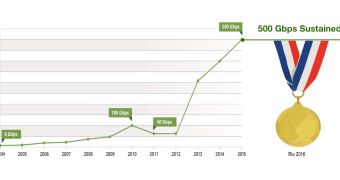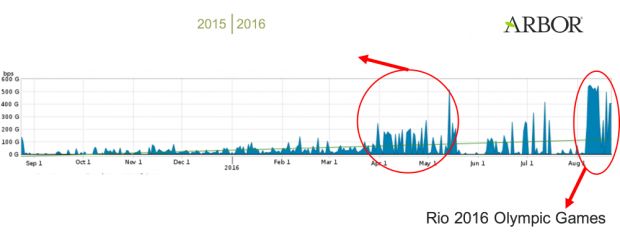Anonymous promised DDoS attacks during the Rio Olympics, and the hacktivists delivered like never before, according to telemetry data from Arbor Networks.
The network security vendor says that, during the two-week event, DDoS attacks were at an all-time high average value, with daily attacks of over 500 Gbps and an incident that peaked at a whopping 540 Gbps. This was not far from the record for a DDoS attack, which is 579 Gbps, detected by the same Arbor Networks in the month of June.
The spike in DDoS activity can be seen better by the graphic embedded at the end of this article. DDoS attacks were very small and far between, but when the Rio Olympics started, there was a visible and brutal activity spike.
Anonymous' call to arms contributed to the huge DDoS activity spike
Most of this can be tracked down to a hacktivism campaign started by Anonymous and called #OpOlympicHacking. The campaign was very popular, and the hacktivists even created a special Windows app that users installed on their PCs and participated in the DDoS attacks using their computer's resources and bandwidth.
With the general hatred shown by Brazilians to their government because of the FIFA 2014 World Cup and the Rio 2016 Olympic Games, the campaign amassed massive support in the country.
Brazilians wanted to show their discontent with the government's decision to shove vast sums of money into organizing these two events, to the detriment of investing in education, healthcare, or other more critical and needy sectors.
DDoS attacks of all sorts recorded during Rio games
On the technical side of things, Arbor revealed that most of the attacks were carried out using DDoS botnets built using LizardStresser, a DDoSing tool open-sourced by Lizard Squad last year.
While LizardStresser is notorious for not being able to launch reflection DDoS attacks, Arbor noted that reflection (amplification) attacks were also recorded, meaning that other types of botnets were also involved.
Arbor says that a large proportion of the attack volume consisted of reflection attack vectors such as DNS, Chargen, NTP, and SSDP.
Classic packet flood attacks using UDP and TCP SYN packets were also deployed, along with application-layer attacks against Web and DNS servers.
GRE protocol used for DDoS attacks after a long time
The Rio DDoS attacks also saw the resurgence of the Generic Routing Encapsulation (GRE) protocol as a valid option for launching DDoS attacks.
Most of the targets were organizations affiliated with the Olympics, and some of the DDoS attacks against these institutions started well before the opening ceremony.

 14 DAY TRIAL //
14 DAY TRIAL // 

